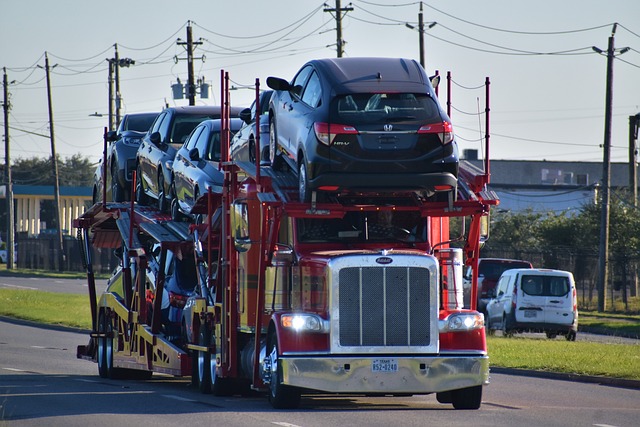Unleash the potential of your new utility trailer with our comprehensive guide tailored for Ontario. This step-by-step journey covers everything from understanding crucial features and preparing your vehicle, to a detailed assembly process. We navigate legal requirements, including registration, licenses, and insurance, ensuring compliance in Ontario. Discover expert maintenance tips to ensure your dump trailer stands the test of time. Optimize your experience and hit the road with confidence!
- Understanding Your Dump Trailer: Features and Requirements
- Preparing the Vehicle: What You Need to Know Before Setup
- Assembly Process: Step-by-Step Guide to Building Your Trailer
- Legal Considerations: Registration, Licenses, and Insurance in Ontario
- Maintenance Tips for a Longevity of Your Dump Trailer
Understanding Your Dump Trailer: Features and Requirements
A dump trailer, as the name suggests, is designed for transporting loose materials like dirt, gravel, or debris. Understanding its key features and requirements is crucial before setting it up. Modern dump trailers come with various innovations such as hydraulic lifts for easy loading and unloading, sturdy construction to withstand heavy loads, and safety mechanisms like stable stands and secure tie-down points.
Before you begin the setup process, ensure your trailer meets all necessary regulations in Ontario, including weight restrictions, dimensions, and required lighting and braking systems. Familiarize yourself with the controls, understand how to operate the hydraulic system, and ensure proper maintenance procedures are followed to prolong its lifespan.
Preparing the Vehicle: What You Need to Know Before Setup
Before you begin setting up your new utility trailer, it’s crucial to prepare your vehicle for the task ahead. In Ontario, ensuring proper compatibility between your rig and the dump trailer is essential for a safe and smooth towing experience. Verify that your vehicle meets the recommended weight and hitch requirements specified by the trailer manufacturer. Check your owner’s manual to confirm the vehicle’s towing capacity and ensure it aligns with the trailer’s loaded weight.
Additionally, inspect your vehicle’s hitch, safety chains, and lighting systems. Make sure they are in good working condition and properly adjusted. Secure any loose connections and ensure all lights are functioning correctly, as this is critical for both safety and legal compliance on Ontario roads. Remember to consult a professional if you have any doubts or need assistance with the setup process.
Assembly Process: Step-by-Step Guide to Building Your Trailer
Building your new utility trailer, especially a dump trailer, is a crucial step in making sure it’s set up correctly and safely for your needs. Here’s a step-by-step guide to help you through the assembly process. Start by unfurling all the components – wheels, axles, frame, and bed – ensuring each piece is present and undamaged. Next, assemble the frame according to the manufacturer’s instructions, securing all joints with proper hardware. Once the frame is sturdy, attach the wheels and axles, making sure they are properly aligned for smooth rolling.
Next, build the trailer bed, starting with the bottom panel and following the manufacturer’s guidelines. Secure sides and front/rear walls, ensuring a watertight seal to protect your cargo. After the bed is assembled, attach it firmly to the frame using robust connectors. Double-check all bolts and screws for tight security. Remember, each step in the assembly process requires attention to detail and adherence to safety standards, especially when dealing with heavy equipment like a dump trailer.
Legal Considerations: Registration, Licenses, and Insurance in Ontario
In Ontario, owning a utility trailer requires adherence to specific legal considerations for safe and compliant operation. The first step is registration; all trailers over a certain weight (typically 450 kg or more) must be registered with the Ministry of Transportation. This process involves providing necessary documentation, including proof of ownership and vehicle inspection certificates. Additionally, obtaining the appropriate licenses is crucial. Drivers operating dump trailers need a Class G driver’s license or an equivalent, ensuring they meet the required training and testing standards.
Insurance coverage for your dump trailer is another vital aspect. Ontario law mandates that trailers be insured under a comprehensive policy, protecting against potential damages, theft, or liability during operation. Ensure you understand the insurance requirements specific to utility trailers, considering their unique nature and use cases, especially when hauling various materials. Proper registration, licensing, and insurance not only comply with legal obligations but also contribute to safe handling and responsible ownership of your dump trailer in Ontario.
Maintenance Tips for a Longevity of Your Dump Trailer
Regular maintenance is key to ensuring your dump trailer serves you well for years to come. Start by inspecting it thoroughly after each use, checking for any signs of wear and tear, such as damaged or loose hitches, frayed cables, or missing or damaged parts. Address these issues promptly to prevent them from escalating.
Keep your trailer clean and dry, wiping down the interior and exterior regularly with a soft cloth or brush. This simple step helps protect against rust and corrosion, especially in Ontario’s damp climate. Regularly lubricate all moving parts, like axles and wheels, using the recommended lubricant for optimal performance and longevity. Don’t forget to check tire pressure often, maintaining the correct PSI to enhance safety and reduce wear.
Setting up your new utility trailer in Ontario is a rewarding process that opens doors to enhanced versatility and efficiency. By understanding your dump trailer’s features, preparing your vehicle, assembly, navigating legal considerations, and maintaining it properly, you’ll enjoy years of reliable service from your investment. Remember, the right setup and care ensure not just functionality but also safety on Ontario’s roads.




